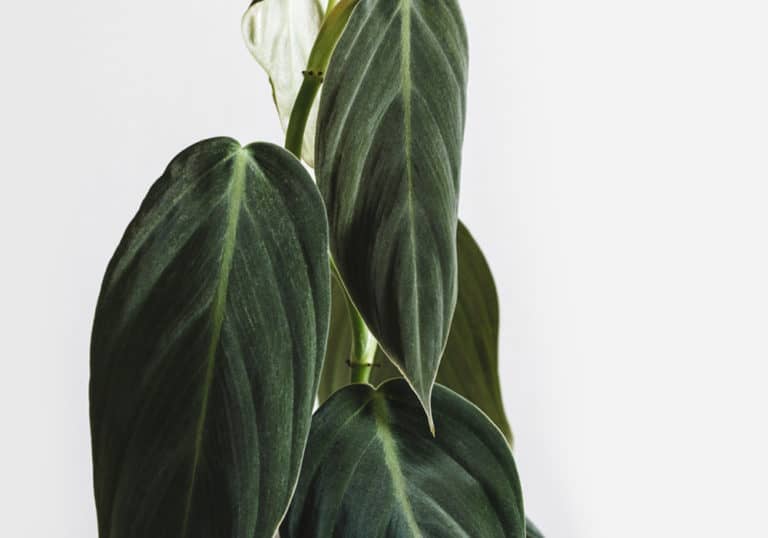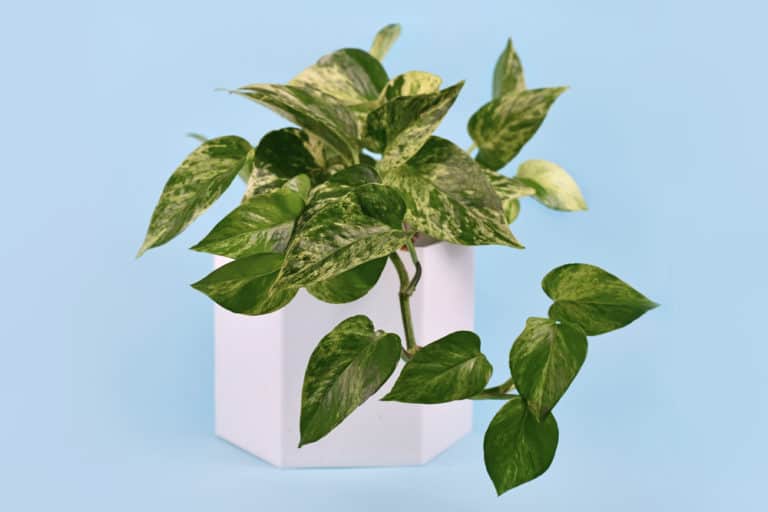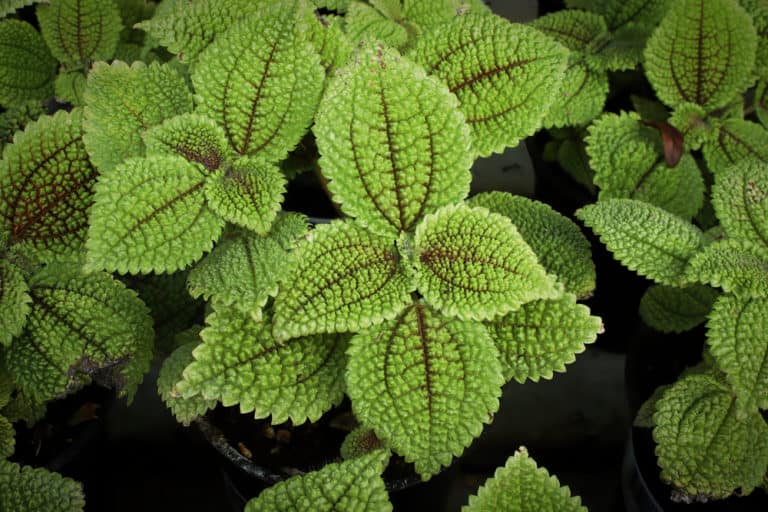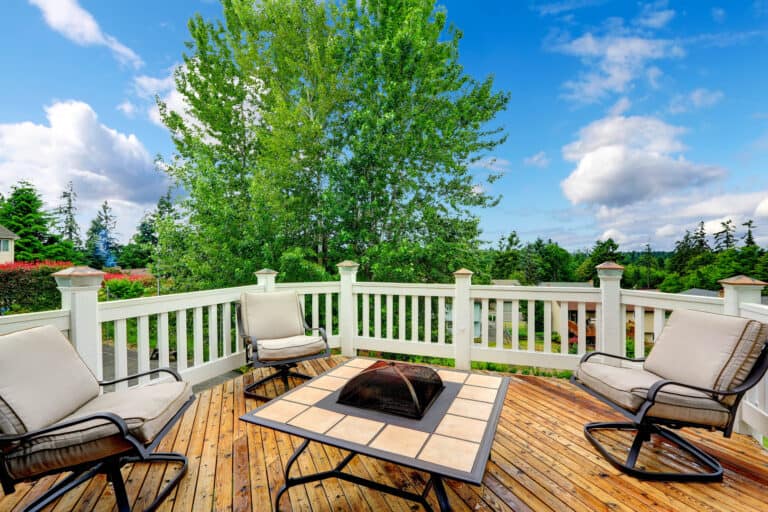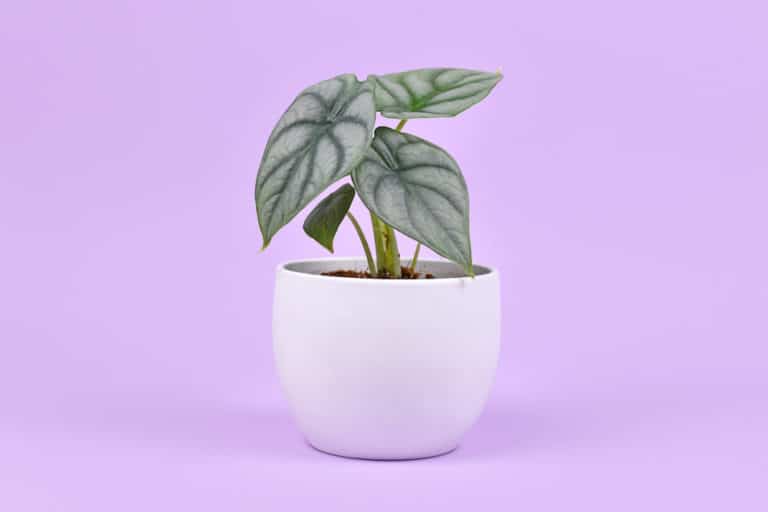Alocasia Reginula ‘Black Velvet’ Care Guide (2024)

Alocasia black velvet is one of the jewel Alocasias, and is truly a gem of a tropical plant.
Alocasia reginula has dark, velvety leaves veined with silver, creating a gorgeous display worthy of a special spot.
Its compact size lets it fit into even a small space, so no matter how tiny your home is, you will have room for this little beauty.
| Scientific Name | Alocasia reginula |
| Common Name | Alocasia black velvet, Black Velvet Elephant Ear, Little Queen Alocasia |
| Light | Bright indirect sunlight |
| Watering | Water when the top 2 to 3 inches of soil are dry |
| Temperature | 60 to 86ºF (15 to 30ºC) |
| Hardiness Zone | 10 to 12 |
| Humidity | 70% |
| Soil Type | Rich, quick-draining |
| Soil pH | 5.5 to 6.5 (mildly acidic) |
| Fertilizing | A balanced feed once a month in spring and summer |
| Repotting | Every 2 to 3 years |
| Pruning | Only to remove dead leaves |
| Propagation | Division |
| Toxicity | Toxic to humans and pets |
| Mature Size | 10 to 15 inches as a houseplant |
| Bloom Time | Rarely flowers indoors |
What’s Unique About Alocasia Black Velvet?
While the Alocasia black velvet plant was only described in 1998, it has been a rarely-grown houseplant for more than a century.
Native to the rainforests of Sabah on the tropical island of Borneo, it was first discovered by plant explorers in the 1860s.
Alocasia black velvet plants are prized for their dark, luxurious leaves shot through with veins of silver.
Growing Alocasia black velvet is easier than a lot of other members of the Alocasia family, so you don’t need to be a plant expert to keep it thriving.
It’s equally well-suited to cultivation as a terrarium or potted plant.
Alocasia Black Velvet Care
In the tropical rainforests of Borneo where Alocasia reginula originates, this petite plant grows on the forest floor in moist soil and dappled shade.
That’s the ideal of Alocasia black velvet plant care, but you don’t need to turn your home into a damp jungle.
Just ensure bright, indirect light, warm temperatures and high humidity and your Alocasia reginula care will be just fine.
Light
In the state of Sabah in Borneo, the hot equatorial sun shines 6 to 8 hours a day, but that doesn’t mean that your Alocasia reginula is used to direct sun.
It grows far below the tree canopy, where the sun’s rays get filtered on their way to the ground, so Alocasia black velvet light requirements are for bright but indirect light. That works out to about 10,000 to 20,000 lux.
Alocasia reginula light needs can be met in a north or east-facing window where the light is never too intense.
However, if all you have are rooms facing south or west, keep them a few feet back from the window to keep them out of the full sun. Otherwise, you run the risk of damage to the leaves.
Watering
It rains a lot in the Sabah rainforests. Even the driest seasons average more than 2 days a week of rainfall. Thus, Alocasia reginula is used to moderately moist soil at all times.
You should water Alocasia reginula whenever the top 2 or 3 inches of the soil have dried out, but never let the soil get drier than that.
The best way to meet Alocasia reginula’s watering needs is by slowly pouring room temperature water slowly over the entire surface until it is fully saturated. Stop when water starts to trickle out the bottom, and never let the pot sit in wet soil.
You will need to do more Alocasia black velvet watering in hot summer weather than in the winter when the plant goes into its dormant state.
Temperature
Sabah is consistently hot all year. The average high is around 90ºF (32ºC) every month, and nighttime lows hover around 75ºF (24ºC).
In your home, the recommended Alocasia black velvet temperature range is a little more reasonable than that, between 60 to 86ºF (15 to 30ºC).
Basically, whatever is a comfortable temperature for you will be a good temperature for Alocasia reginula.
Of course, your Alocasia reginula will appreciate a summertime outside in a shady spot to enjoy some really hot weather.
As might be expected for a tropical native, however, it has little temperature tolerance below 55ºF (13ºC), and no frost hardiness at all.
Humidity
The humidity in the Borneo rainforests stays between 80 to 90% all year long, so your Alocasia black velvet humidity requirements are, not surprisingly, high.
While the ideal humidity for Alocasia reginula is around 70%, it may tolerate a humidity level as low as 50%, but monitor it closely. If its leaves develop brown edges, you will need to provide it with a bubble of higher humidity.
Misting is not the best method since if the leaves get too wet fungal diseases may set in. A pebble tray will probably not get the air moist enough.
You can grow this small plant in a terrarium or set it near a small humidifier to give it the humidity it craves.
Soil
In the rainforests of Sabah, Alocasia reginula grows on the forest floor in porous, spongy soil.
Alocasia black velvet soil has to both retain moisture, but also maintain an open structure that will drain easily and let the roots breathe.
The pH level for Alocasia reginula should be from 5.5 to 6.5 pH or slightly acidic.
You can easily create a custom soil for Alocasia reginula. Try combining 1 part potting soil or peat moss with 2 parts perlite and 1 part orchid bark.
You can also add a handful of well-rotted compost or worm castings to the soil mix.
Fertilizer
You do not need to use a lot of Alocasia black velvet fertilizer, but regular light feedings in the growing season can be beneficial.
You use a standard indoor liquid plant fertilizer for Alocasia reginula, with a balanced fertilizer ratio of 15-15-15. Dilute it to half the recommended strength to avoid burning the roots.
Once a month in spring and summer, after you’ve watered your Alocasia reginula, slowly pour the solution over the entire soil surface until it is absorbed.
Stop these monthly feedings in the autumn and don’t start again until the following spring, as it does not need feeding when it is in its dormancy.
Potting & Repotting
You should think about Alocasia black velvet repotting every 2 or 3 years, or whenever you see that it is becoming rootbound.
This slow-growing plant doesn’t mind tight quarters, so don’t rush into repotting Alocasia reginula unless it’s necessary. Wait until its roots have filled up its current pot.
The best time of year for repotting is early spring, right at the beginning of its growing season.
Do not go up more than one pot size, as too much soil will increase the risk of root rot.
Your new pot can be plastic or glazed to conserve moisture, but it must have holes so the soil can drain excess water easily.
Always use fresh potting soil after cleaning off as much as the old as possible, to prevent the build-up of pathogens.
Pruning
You will have very little Alocasia black velvet pruning to do.
Alocasia reginula grows slowly and each leaf is precious, so the only reason for cutting Alocasia reginula is to remove dead or diseased leaves.
This will keep your Alocasia reginula looking its best. As well, pests and disease are more likely to flourish on damaged foliage, so you will be helping your plant stay healthy.
Trim these leaves by cutting the petiole right against the main stem. This will encourage new leaves to grow.
While flowering is extremely rare, the blooms are unimpressive, so if you do see flower stalks emerging, cut them out. That way, your Alocasia reginula can concentrate on leaf production.
Propagation
Alocasia black velvet propagation is usually done through root division at the same time as repotting.
While they can be started from seeds, it takes a long time to grow a plant of any size using that method.
To propagate Alocasia reginula, start by removing the root ball from its pot, and clean off as much soil as possible so that you can clearly see the roots.
You may see offsets, or new baby plants, growing around the mother plant. Gently tug them away.
Otherwise, simply cut a piece of a tuber with both roots and stems.
Plant these new Alocasia reginula plants in their own small pots, and water them well to settle them in.
Also, make sure to check out our in-depth Alocasia cuprea plant care guide.
Common Problems of Alocasia Black Velvet
You might think that with its luxurious look that there might be lots of potential Alocasia black velvet problems, but you would be wrong.
You are unlikely to have any problems with Alocasia reginula if you simply take proper care of your tropical plant.
However, if you do notice that the leaves are showing some signs of distress, you should be able to solve the issues.
Pests
There are really remarkably few Alocasia black velvet pests.
The most likely of bugs to infest your Alocasia reginula are spider mites.
However, if you keep the humidity high enough around those velvety leaves, you shouldn’t see even those insects.
If you do notice fine, sticky webs on the leaves or stems, deal with them fast before the infestation proceeds too far.
The best way to get rid of spider mites is by giving your Alocasia reginula a good shower. Wash all the stem and leaf surfaces.
Then, use an insecticidal soap spray once a week for about a month to make sure you’ve gotten everything.
Diseases
Most Alocasia black velvet diseases are caused by improper watering.
If you keep the soil of your Alocasia reginula saturated, the roots won’t be able to breathe and fungal diseases can take hold.
When the leaves start to turn yellow and the stems get soft, check the roots. If they are black and smelly, you’ve got a case of root rot.
On the other hand, if the leaves are developing black, brown, or yellow spots that multiply and grow in size, your Alocasia reginula has leaf spot. That’s a catchall term for a variety of fungal or bacterial diseases, usually a result of the leaves staying wet.
Whatever disease your plant has, cut off all the infected parts and replant it in fresh soil in a disinfected pot.
Growing Problems
You won’t have any growing problems if your Alocasia reginula’s growing conditions are ideal.
However, if you have a sick plant, all you need to do is improve those conditions to bring your plant back to a healthy life.
Curling leaves can be either an indication of dry soil or too much sun.
Brown tips may also mean dry soil or too much fertilizer.
On the other hand, brown edges are usually a warning that your Alocasia reginula needs a higher humidity level.
If the stems and leaves are drooping but haven’t changed color, low light is probably to blame.
Toxicity of Alocasia Black Velvet
Alocasia reginula is toxic to humans and animals.
Like all members of the araceae family, all parts of the plant have calcium oxalate crystals, or raphides. These tiny, sharp structures can pierce and irritate delicate tissues.
Because of its toxicity, you should take precautions when growing it in a home with children or pets.
For Humans
Alocasia reginula is toxic to humans but rarely causes serious problems.
When you handle the plant, you should wear gloves to protect your skin from the sap, which can cause a rash.
Children are a bigger concern because their endless curiosity can lead to them trying a taste of the foliage.
They probably won’t take more than one bite because the crystals will quickly cause sharp pain. Rinse their mouth and give them something cold to help numb the pain.
However, if your child has a swollen tongue or trouble breathing, take them to the emergency room as soon as possible.
For Pets
Pets can have a serious reaction to ingesting Alocasia reginula foliage.
If your cat, dog, or rabbit eats a Alocasia black velvet leaf and starts drooling excessively, wheezing, or has vomiting or diarrhea, don’t try to treat it yourself.
Instead, take it to the veterinarian immediately to avoid the chance of permanent internal damage.
It’s best to prevent a crisis like this by placing your Alocasia reginula somewhere out of reach of pets and children.
Because it stays small, you can easily find a location for it on a shelf or mantlepiece. A terrarium is also a good spot to keep it away from curious creatures.
Alocasia Black Velvet Appearance
Its common name really sums up the Alocasia black velvet appearance. The luxurious leaves are like the little black dress of the plant world, complete with silver bling.
The compact size of this slow-growing perennial makes it a perfect choice for small spaces, where it will make a big statement all on its own.
Foliage
The foliage of Alocasia black velvet is absolutely gorgeous. The large, black, velvety leaves will adorn any room they’re in.
Each leaf has an almost black pigmentation, a handy evolutionary trick to absorb as much light as possible on the shady rainforest floor. The brilliant silver veins set off the dark color perfectly. The purple undersides add another dimension of color.
The leaves grow to 6 inches long and 2.5 inches wide, in an oval shape with a pointed tip.
The velvety surface can be a real dust collector, so gently wipe the leaves down periodically so that they will look their best and photosynthesize at peak efficiency.
Flowering
While Alocasia black velvet flowering does occur in the wild, do not expect your potted plant to do any blooming.
It’s not as if the Alocasia reginula flower is anything to get excited about, anyway. It consists of a small, white spadix surrounded by a pale green spathe, emerging in early summer. The berries that follow can be used to start new plants from seed, but it’s a long, slow process.
They are often not visible under the spreading leaves and have no fragrance.
On the off chance that your Alocasia reginula does show signs of blooming, it’s recommended that you cut off the flower stalks and let it concentrate on growing leaves.
Size and Growth
When grown indoors as a potted plant, the size of Alocasia black velvet rarely exceeds 15 inches in height with a similar spread.
Outdoors in a tropical climate, plants can be as tall as 3 feet, with a 2.5-foot spread. The leaves are proportional to the increased size of the plant, sometimes 2 feet wide.
It has a slow growth rate, taking several years to reach its mature size.
Branching stems emerge from the rhizomes, with multiple stems developing over time.
It does not need to be staked, as it is naturally a low-growing plant that spreads out rather than stretching up.
Alocasia Black Velvet Fragrance
There is no Alocasia black velvet fragrance. The foliage has no scent, and even the rare flowers are fragrance-free.
However, not having a scent can actually be an advantage in many different situations.
For instance, if you are growing this compact beauty in a small studio apartment, a plant with an overwhelmingly strong scent would probably be too much to live with.
As well, many public places, including nursing homes and offices, actually prohibit strongly scented plants because some people are allergic to them.
The luxurious look of this velvety plant is enough of a treat without needing a fragrance as well.
Suggested Uses for Alocasia Black Velvet
Because it’s small with an intense appearance, you can find many ways to use an Alocasia reginula plant in your indoor decor.
Since it absolutely craves high humidity, you can find a spot on your bathroom counter to showcase its luxurious look while letting it drink up the air’s moisture.
If you want a terrarium plant, Alocasia reginula is a perfect candidate.
The deep black leaves with their silver veins will be an absolute stand-out against the white walls of a contemporary loft or enhance a more traditional setting.
Outdoors in a tropical climate, you can expect your Alocasia reginula to grow taller and wider, making it an ideal specimen for a shady spot.
FAQ
What is Alocasia black velvet?
Alocasia black velvet is a perennial tropical plant native to the rainforests of Sabah on the island of Borneo, where it grows on the forest floor.
How to identify Alocasia black velvet?
Alocasia black velvet has oval leaves about 6 inches long. They have a velvety texture and are almost black in color with brilliant silvery veins.
How to care for Alocasia black velvet?
Alocasia black velvet should be grown in rich, well-draining soil and kept in a spot with bright, indirect light, warm temperatures, and extremely high humidity.
How to grow Alocasia black velvet indoors?
The Alocasia black velvet plant can be grown as a potted plant with consistently high humidity and moist soil in a warm and bright location.
How to grow Alocasia black velvet outdoors?
Alocasia black velvet can be grown outdoors in zones 10 to 12, in a shady location with soil that is kept moist but not waterlogged.
How fast does Alocasia black velvet grow?
The Alocasia black velvet plant has a slow to moderate growth rate, taking several years to reach its full size of 15 inches in height.
How tall does Alocasia black velvet grow?
Alocasia black velvet usually tops out at 15 inches when grown indoors as a potted plant, although in a tropical region, it may reach 3 feet.
How to make Alocasia black velvet grow faster?
Alocasia black velvet will grow the fastest when it is grown in very high humidity and warm temperatures. Extra fertilizer will stunt growth, not encourage it.
How to stake Alocasia black velvet?
Alocasia black velvet is not a climbing plant but a low-growing plant with strong stems that do not need extra support, so staking is not recommended.
How to pot Alocasia black velvet?
Alocasia black velvet should be planted in rich but well-draining soil that will let the roots breathe in a plastic or glazed pot with drainage holes.
How to revive Alocasia black velvet?
If your Alocasia black velvet has become limp from a lack of water, try to revive it by letting the soil absorb as much water as possible before draining all the excess.
Why is my Alocasia black velvet dying?
Your Alocasia black velvet may have a disease such as a root rot or leaf spot caused by poor watering practices. Cut out diseased tissues and replant them in fresh soil.
Why is my Alocasia black velvet drooping?
Your Alocasia black velvet may be placed in a spot with too low light levels, and the leaves are stretching out as far as possible to get the maximum amount of light.
How cold can Alocasia black velvet tolerate?
Alocasia black velvet needs consistently warm temperatures between 60 to 86ºF (15 to 30ºC), and will not tolerate anything below 55ºF (13ºC) when it will stop growing.
How to get rid of pests on Alocasia black velvet?
Alocasia black velvet is not susceptible to many pests, but if you see spider mites, spray down the whole plant in the shower and follow up with insecticidal soap.
Is Alocasia black velvet toxic to cats?
Yes, the Alocasia black velvet plant is toxic to cats. If your cat starts vomiting or wheezing, you should take it to the veterinarian at once.
Is Alocasia black velvet toxic to dogs?
Yes, Alocasia black velvet is toxic to dogs. If your dog has vomiting or diarrhea or starts drooling or wheezing, take it to the veterinarian.
Is Alocasia black velvet toxic to children?
Yes, Alocasia black velvet is toxic to children. If your child eats some foliage and has a swollen tongue or trouble breathing, take them to the emergency room.
Is Alocasia black velvet toxic to humans?
Yes, Alocasia black velvet is toxic to humans. If some of the sap gets on your skin, rinse it off to prevent a painful rash from developing.
Does Alocasia black velvet have a scent?
Alocasia black velvet’s foliage and flowers do not have any scent, so it can be used in locations where plants with a strong fragrance are not suitable.


